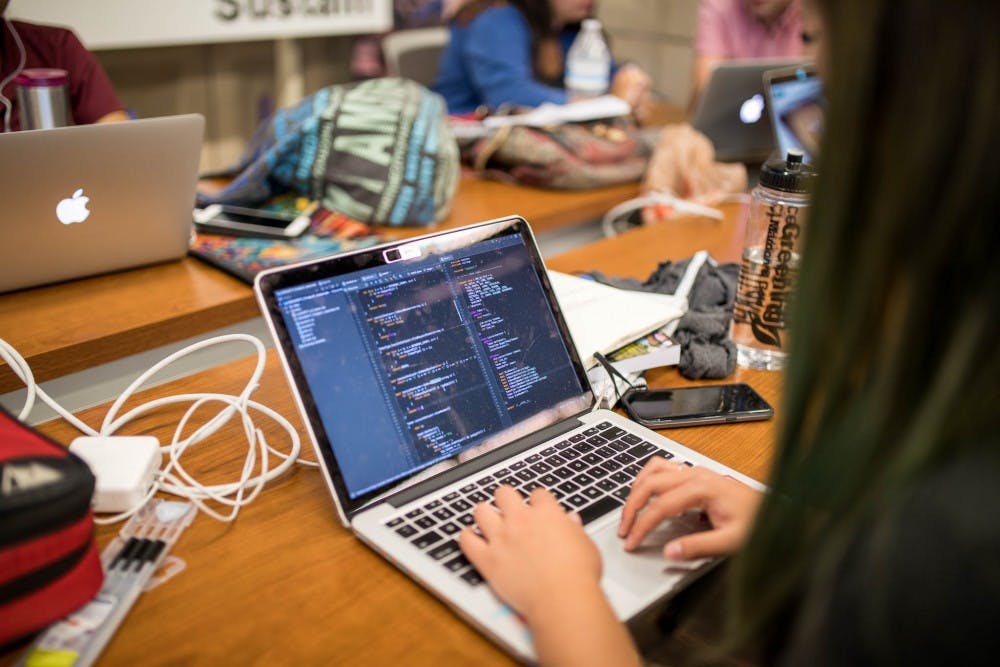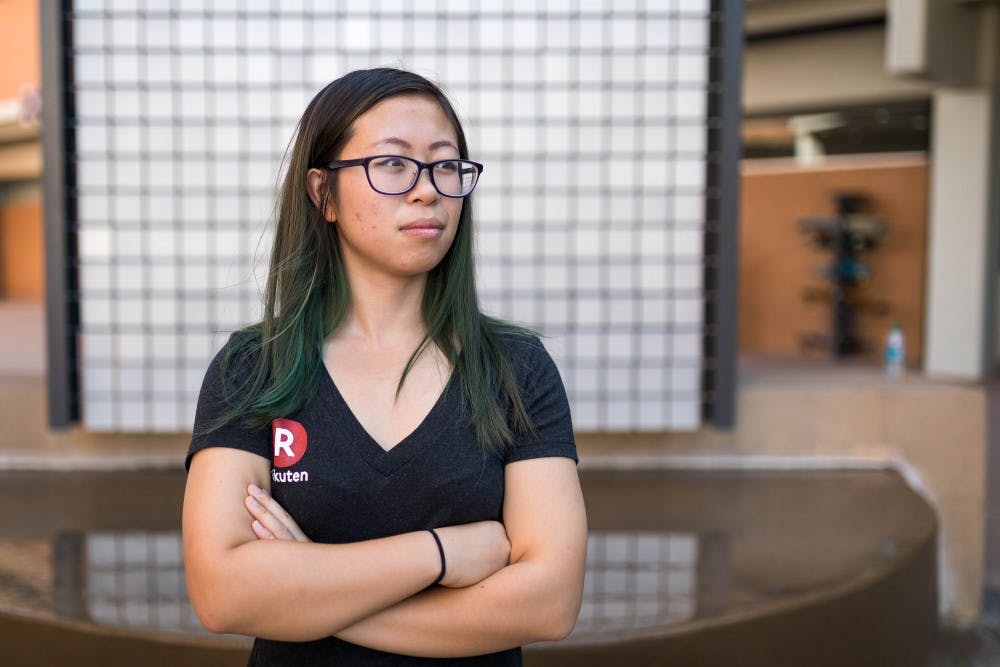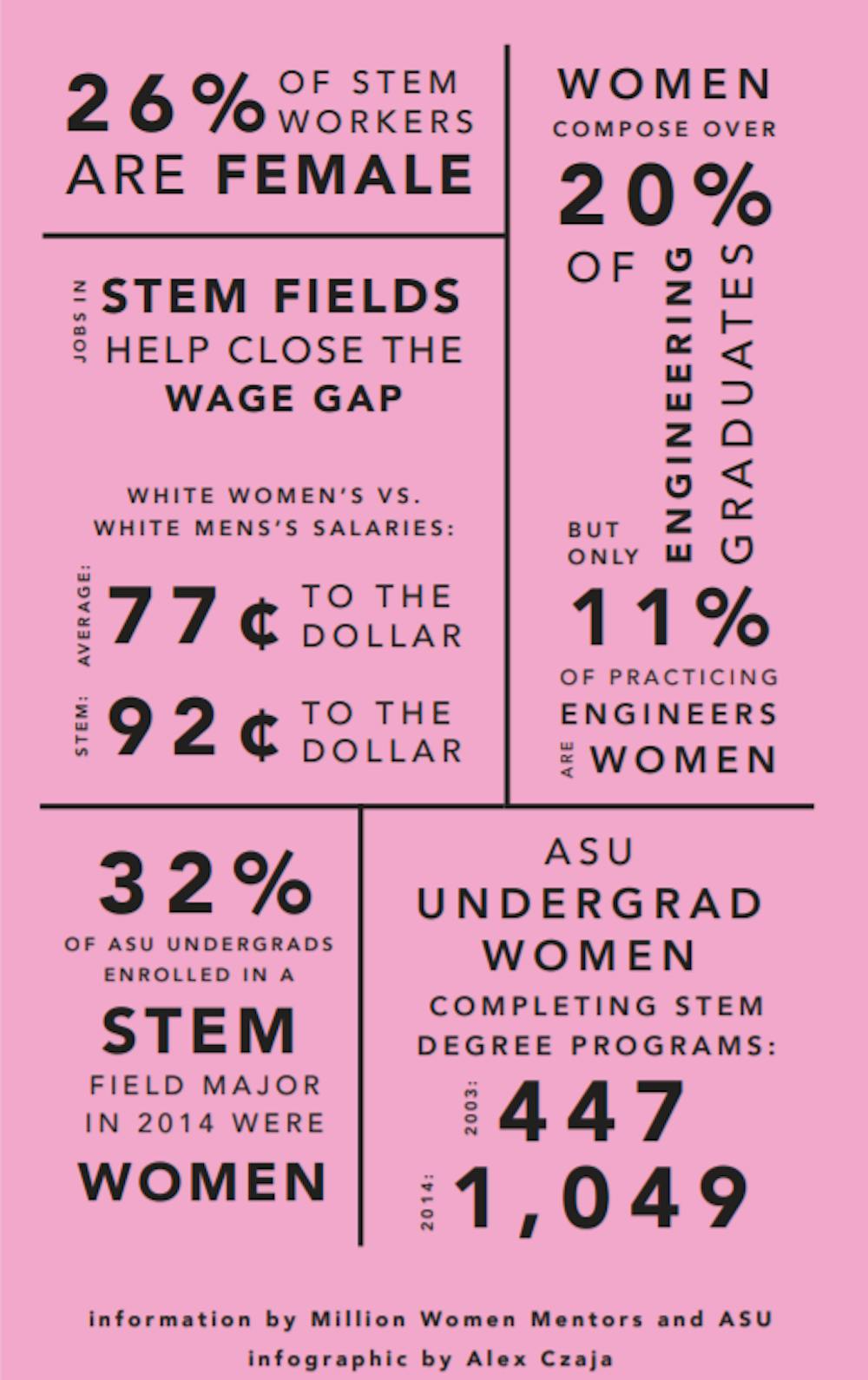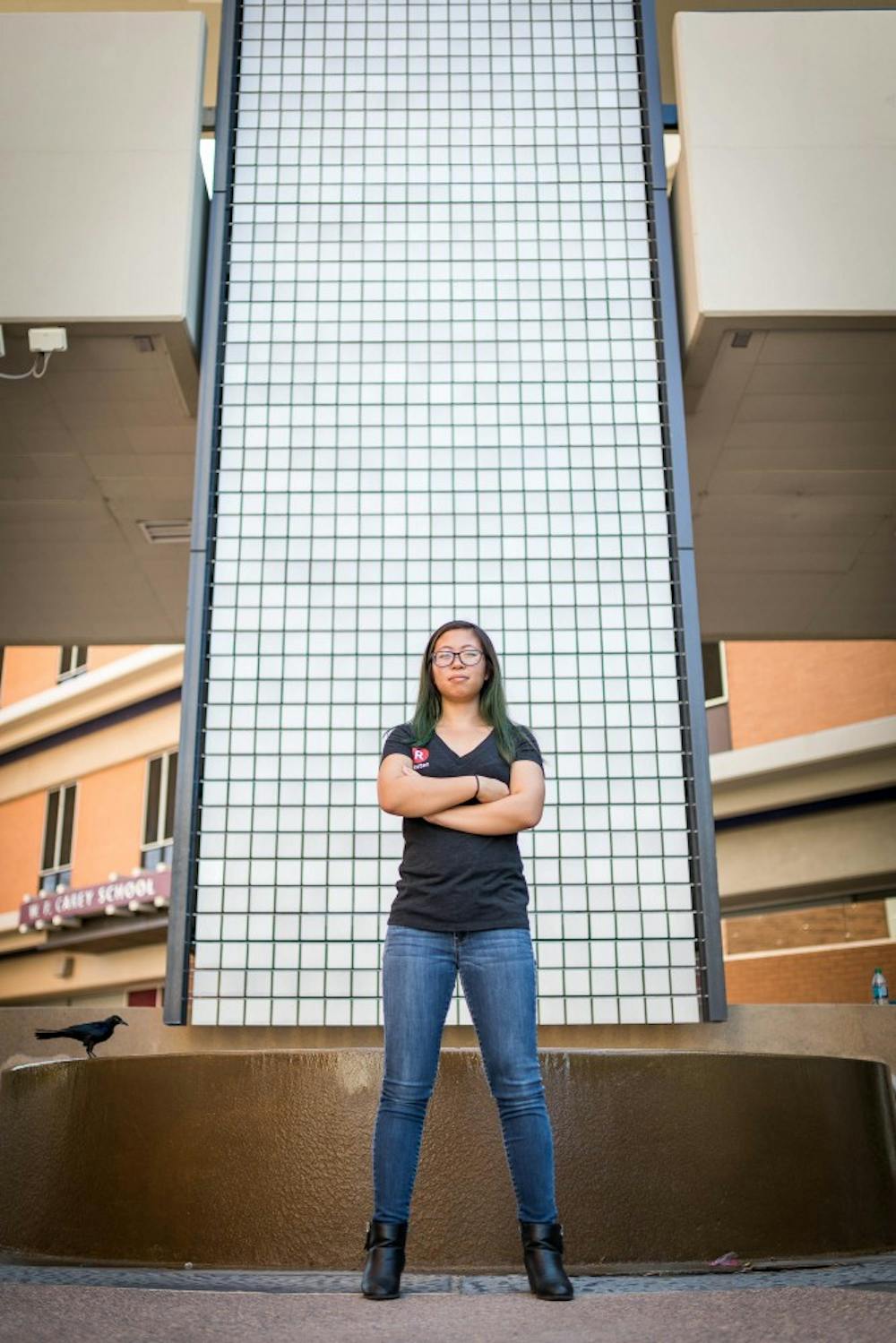The glass doors of Arizona State University’s Changemaker Central office open easily as I search the room for one student changemaker in particular: Diana Chen.
Chen is waiting for me at one of the long wooden tables towards the west entrance to the building. She’s dressed casually and looks just like any other student preparing for the upcoming semester. No one would guess at first glance that she had the opportunity to work as a software engineering intern for Google this past summer.
Chen was still interning for the company when a controversial internal memo was released. James Damore, a software engineer for Google, claimed the gender gap in software engineering is not “socially constructed,” but is due to biological differences between men and women.
“I was kind of an outsider to (the memo) because my department was really awesome,” Chen says. “Everyone was super nice, but you’re at a big company and there are going to be people like that. Just knowing those people are present it’s still hard to read those things and (have) people question why you’re there...it’s not like they said it to my face, but those things exist and bother you no matter what.”
However, Chen says she’s never personally felt discouraged or like she doesn’t belong in the field she’s chosen.
“For me, it’s not really a question if I would go into STEM. Since middle school I’ve always really loved math and science,” Chen says. “...My senior year of high school I took my first computer science class and then I was like, ‘Okay this is what I want to do.’”
Chen is a junior computer science major whose passion for coding has led her to become part of the thousands of women who choose science, technology, engineering or mathematics majors at ASU. According to a study released by the university in February 2016, 17,495 undergraduate students enrolled themselves in a STEM field major in 2014, of those 5,708 (32 percent) were women.
To put things into perspective, those who chose a STEM major in 2014 would be graduating this May. According to the same study, 1,049 undergraduate women completed their degree program in 2014, but ASU expects those numbers to increase.
Although this study demonstrated less than half of STEM majors at ASU are composed of women, the numbers have grown exponentially in the last decade. During the 2002-2003 school year, only 447 undergraduate women obtained a STEM degree.
However, after graduation, finding (and keeping) a career in a STEM field may prove difficult for women like Chen who want to enter a white, male-dominated field.
The STEM Gender Gap
Across the broad spectrum of STEM, only 26 percent of workers are female. Women compose over 20 percent of engineering graduates, but only 11 percent of practicing engineers are women, according to Million Women Mentors.
In terms of the wage gap, however, jobs in STEM fields are actually beneficial for closing the difference between men and women’s salaries. Typically the difference between white women versus white men’s wages is about 77 cents to the dollar, but in STEM it’s about 92 cents to the dollar, according to Million Women Mentors.
Million Women Mentors is a national mentorship program that aims to keep young women “interested and confident” in STEM. The organization has nearly 2 million female mentees and nearly 850,000 completed mentorings across the country, according to its website.
Janell Wiseton, the National Senior Advisor-STEM Connector for Million Women Mentors says it’s important to educate young women on the many different career paths they can take with a STEM degree.
Indeed, there’s been speculation in recent years that the “STEM pipeline,” or the phenomenon of large numbers of women dropping out of the STEM career path at a certain point, is no longer true, but instead it’s a lack of education and encouragement that keeps women from entering into STEM in the first place.
“We’re not clearly articulating to girls how these (STEM) careers can help people,” Wiseton says. “...the number one reason all kids, girls or boys, do not follow a STEM career path is because they don’t know about them.”
In 2014, ASU partnered with the Million Women Mentors program to encourage and assist female STEM majors at the university in completing their degrees. The partnership hoped to attract professionals from within the local community to join the Million Women Mentors’ mission, according to an ASU Now article published three years ago.
While Wiseton says the program still maintains friendly ties with ASU, the program lost its biggest supporter, the former Vice Provost and Dean of the College of Technology and Innovation, Mitzi Montoya after she left the university in 2015.
However, female STEM students are still taking advantage of other resources available to them at the university.
Breaking the glass ceiling
Circling back to Chen, she brightens as she continues to talk about her experiences at Google and the university itself. She lists off several technical coding terms and I have to stop and ask her to define them for me. There’s no doubt that Chen is one of the top contenders in her field here at ASU: She knows her stuff.
Over the summer, Chen and a team of other software engineers created an app called Technical Interview Exercises or TIE that helps prepare future software engineers for technical interviews in which employers ask interviewees to solve a problem using programming language.
“Pretty much everyone has to go through a technical interview process,” Chen says. “It’s pretty unique to the industry. This (program) is to help better prepare minority students or women who want to join the field...because they don’t always have those types of things available to them.”
Now that she’s back at ASU, Chen says she’s still involved with programs on and off campus that help educate women and minorities on the possibilities of STEM careers.
Off campus, Chen is working closely with the Million Dollar Teaching Project to increase education opportunities for people interested in coding.
“I’m working with (the founder of Million Dollar Teaching Project) to build a computer science curriculum for the Phoenix Coding Academy so we can help teach minorities and get more people involved in computer science in a fun, project-based way,” Chen says.
It’s clear educating the local communities on the possibilities of coding is important to Chen. She’s also working on a separate project from within the university to bring more technology to classrooms.
“...If you don’t have a computer science class at your school you’re not really going to get exposed to it and you might not think it’s for you,” Chen says. “So you just might never try it and never know.”
On campus, Chen has participated in both the Women in Computer Science and Women in STEM clubs. Last year, she served as the co-president of the Women in STEM Club.
A few weeks prior to meeting with Chen, I sat down with Phoebe Newell and Farizah Ali, Women in STEM’s current president and Chen’s former co-president, respectively.
Newell is a junior studying molecular biosciences and biotechnologies. Ali is also a junior studying biochemistry and global health. They both joined Women in STEM to meet young women within the other fields of STEM.
After a period of inactivity, the club was reinstated in the fall of 2015 with a new executive board and meets every Monday in the Memorial Union. As a part of the club’s main education initiative, Ali says the club goes to a local middle school about every other week to do a hands-on activity related to different STEM fields.
“One week we might do programming activities online to teach them how to code,” Ali says. “We’ve done chemistry experiments and we’ve done math like geometry for Pi Day.”
Newell mentioned that although her classes as a life sciences major are split fairly evenly between male and female students, she’s still experienced brushes of sexism within her time as a female STEM student. Once, Newell was asked if her future career path would affect the amount of time she’d have to raise a family.
“It just struck me as funny because no one would ever ask a guy that,” Newell says. ...so I think there’s kind of those subtle pressures (in society).”
In order to combat those societal pressures, Newell also added the club is very focused on young girls interested in STEM to see members of the club as role models because they believe representation is correlated to retention rates in STEM fields.
Why Representation in STEM Matters
As evidenced by the statistics above, the majority of people making discoveries and creating new technologies are doing so from a white, male perspective.
There’s evidence some “solutions” in today’s world don’t work for everyone.
A video recently surfaced on Twitter of a man unable to use a motion-activated soap dispenser because his skin is too dark for the machine to see him. In a 2014 TEDx Talk medical sociologist Liberty Barnes discusses solutions to male infertility that are overlooked because reproduction is a “woman’s problem.” Car crashes are the leading cause of fetal death because traditional car seats do not properly protect pregnant women. The list goes on and on of problems and solutions that could greatly benefit from racial and gender diversity.
At ASU, the main solution to this problem seems to be encouraging students and faculty members to go out into the community and encourage young girls and minorities to become and stay interested in STEM fields.
Much like the programs Chen worked on and the Women in STEM club, ASU has another program partially funded by the National Science Foundation: The Center for Gender Equity in Science in Technology.
“Really the idea was helping girls get into the STEM field and create awareness of possibilities in the STEM field,” Laila Sarah, the assistant director for CGEST.
From CGEST stems a program called CompuGirls which focuses on teaching middle and high school aged girls how to code and create their own computer programs.
This past year, about 200 girls in Arizona, Colorado and New Jersey participated in the program alongside student mentors and guest speakers from ASU. Sarah says the primary mission of CompuGirls is to tackle social justice issues using technology. Girls who participated worked on extensive, advanced projects like programming robots to help combat sex trafficking or designing virtual worlds to help promote body positivity.
Sarah says it’s important to have diversity in STEM because that’s where the future of the entire world is heading.
“Girls (and) women of color bring in an incredibly unique perspective that...isn’t heard or isn’t seen,” Sarah says. “When we’re talking about sustainable communities or when we’re talking about anything it’s always good to have a diverse perspectives and we believe women and girls bring that.”
Editor's Note: The print version of this story says two men were unable to use a paper towel dispenser. Although there were two men in the video, the correct statement is that one man could not use an automatic soap dispenser because his skin was too dark. This version has been updated to reflect those changes.
Reach the reporter at syaghsez@asu.edu or follow @SavYaghsezian on Twitter.
Like The State Press on Facebook and follow @statepress on Twitter.







